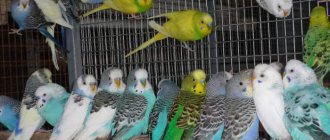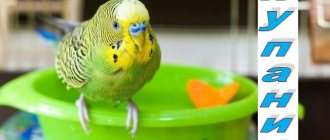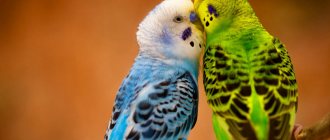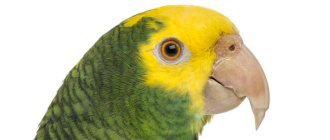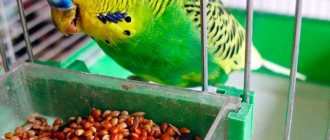Many people keep budgies at home - their care is minimal, but the emotional return is enormous. Before buying, the future owner thinks about how to choose the best budgie: healthy, young, and able to talk. After reading the article, you will learn about all the subtleties: what questions to solve initially, what places sell good birds, what a budgie should look like. And the last thing is what you need to do when you take your baby home, how to help him survive the adaptation.
How to prepare to buy a parrot
Getting a small parrot is as easy as shelling pears: now pet stores are full of different birds, food, and accessories for keeping them. The prices for all this stuff are affordable. Before you start choosing a parrot for your home, you need to think things through. It’s worth discussing your wishes with your family and not forgetting a single detail:
- Watch the video. Even little ones like wavy creatures litter and make noise. They wake up at dawn and chirp all day. Flying around the apartment, they leave droppings behind them, tear off wallpaper and curtains. They spoil documents, books, gnaw flowers.
- Evaluate the space. Select the location where the cage will be located. The wavy does not need a large home, but it still needs freedom. The maintenance rules stipulate that the cage should be kept away from windows, batteries and household appliances. At the same time, parrots do not like to be moved from place to place. Birds should have a permanent corner.
- Make time. Sociable birds require attention; they get bored without people. If you don't have even one free hour a day to talk to, pet, and train your parrot, don't get a pet. Loneliness and then depression await him.
- Select the sex and number of birds. With plenty of time to spend, take one wavy boy. Males learn better and imitate speech. Females are shy and less attached to their owner. Two same-sex birds often quarrel, while opposite-sex birds create a family and raise chicks.
- Collect a first aid kit. It’s not enough just to provide care items and medications; you also need to write down the address and telephone number of the nearest veterinary clinic. The feathered ward will have to be treated, vaccinated, and taken for preventive examinations.
Attention! The down and feathers of budgies provoke an allergic reaction. If anyone in your family is prone to allergies, do not buy the bird.
When all the pros and cons are weighed, and the decision is made that you are buying wavy, it’s time to go to the trading places.
Where to buy a budgie
You can buy a budgie from amateur breeders or at retail outlets:
- in a pet store;
- from a professional breeder;
- by advertisement;
- in a specialized club;
- at the poultry market.
Buying a budgie from a pet store is the easiest option. There are always birds of different colors there. Usually chicks bred at home are sold there. The seller will help you figure out how to choose the right pet parrot. He will tell you about the needs of the bird and recommend equipment. Conscientious traders value the store's reputation and take good care of the birds and do not allow the cages to become overcrowded. If you're lucky, the seller will recommend an individual that's right for you.
A breeder is a person who breeds birds professionally. He knows thoroughly the positive and negative sides of the chick, and can tell everything about health, behavior and possible problems. He will show the parents, name their age and gender. Often, breeders monitor the fate of sold parrots and offer their phone number for consultation.
Attention! When buying a bird from an advertisement, you risk getting a sick, old or malignant bird with which the previous owners did not get along.
In specialized nurseries and clubs, chicks with interesting colors or show ones are often chosen. Here you will find out the exact age of the bird and its origin. Such parrots have a pedigree, a permanent ring, and a corresponding price.
The poultry market should be considered last. In such places, birds live in cramped conditions and dirt. They are poorly cared for due to the huge number of individuals. In such conditions, you may unexpectedly buy a sick parrot. In order not to take a “pig in a poke,” you need to know the signs of a painful condition and imagine the appearance of a healthy wavy.
What does a healthy bird look like?
A sick parrot is not as scary as you might think. But you cannot bring a sick individual into a house where other birds live - it will infect everyone. So how to choose and buy a healthy parrot? Carefully consider his appearance and behavior. Indicators of a successful bird:
- shiny, dense plumage;
- eyes are clean, not cloudy;
- cere without cracks and growths;
- smooth, clean beak;
- smooth skin on the paws;
- proud posture;
- The cloaca area is neat, covered with feathers.
A well-groomed parrot should be well-fed and active. When sitting on a perch, the paws are spread wide and grasp firmly with four toes. If there have been injuries, fractures, the bird has difficulty maintaining its balance and walks awkwardly.
Parrot in the family: pros and cons
Before buying a parrot, you need to weigh the pros and cons.
Positive aspects of having a bird in a house or apartment:
- The feathered one lifts your spirits and distracts you from the drabness of everyday life;
- will become an attentive interlocutor;
- brings surprises every day and diversifies life;
- there will be a living creature in the house who joyfully greets the owner.
It seems incredible, but parrots sense when their owner is sad and make efforts to cheer them up.
The disadvantages are the following:
- The cage and surrounding area must be cleaned daily;
- sometimes you will have to scrub stains off furniture;
- curious birds can chew through wires, damage indoor flowers and tear wallpaper;
- In the morning it won’t let you lie in the owners’ bed, it will wake you up with a joyful cry.
In order for a parrot to talk and behave “decently”, you need to work with it every day, and at the same time not raise your voice.
What is the difference between a chick and an adult?
Ornithologists recommend choosing a budgerigar no older than six months. The growing chick has a flexible psyche, it is easier to tame, and quickly gets used to its new home. In order for your parrot to speak, you need to start training it as early as possible. How to avoid making a mistake with age when purchasing?
Signs of young individuals:
- clear waves on the back and head from the cere. After the first molt, the feathers from the crown to the back of the head acquire one color, without inclusions or patterns;
- black spots on the beak, dark irises, without rings;
- short tail;
- matte shade of feathers, without shine.
You need to examine the bird in the company of relatives. By comparing different individuals, you are more likely to select a young parrot.
Species and breeds
Common parrots for home keeping:
Wavy is the perfect choice for a beginner. Minimal care and maintenance costs make this bird so common. Feathered friends are chosen as follows: - male parrots have black lines on the frontal part and back, which disappear completely after molting; - eye color - black; - young birds have darker beaks than adults. Lovebirds. An interesting feature of this species is the strong attachment between the female and the male. They do everything as a couple - they drink and eat, preen their feathers, play and relax. These birds have bright green plumage and a red stripe on their forehead and chest. Chicks are easier to train than adults. A distinctive feature of the chicks is the black base of the beak and lighter color of the feathers. Cockatiels. Easy to train, kind and talkative birds. The color of the feathers is lemon, with bright orange spots on the cheeks. How to choose the right feathered friend: - to teach a parrot to talk, its age at the time of purchase should not exceed 5 weeks. As a rule, chicks are not afraid of people and go to their own hands; - young birds have gray stripes on their tails, which disappear after the first moult; - The beak of adult birds is light, while that of chicks is dark gray. Jaco. Experienced poultry farmers can safely buy this wonderful, smart parrot for themselves. Grays can easily remember more than 100 words and can easily reproduce song melodies
These birds are quite large, the color of the feathers is gray, the tail has a reddish color. What you should pay attention to when choosing an exotic parrot: - buy birds no older than five months and only from trusted breeders. Chicks born in captivity are flexible, kind and learn fairly quickly.
Wild birds are aggressive and capricious; - the eye color of babies is dark, while in adults the iris is yellow. In young chicks, before the first molt, gray spots can be seen on the plumage.
How many parrots to buy
The number of birds depends on the goals and capabilities of the breeder. If you are choosing a companion who will brighten up your loneliness, it is better to take one talking parrot. Constant communication and care will allow the new pet to become a full member of the family over time. Connoisseurs of silence are advised to get a girl budgerigar, since females are less noisy than males.
If the owners are not home much, the lonely bird begins to feel sad. You can save your feathered ward from sadness by choosing company for him. Two or three individuals can live in one spacious cage. Well, if you have plans for breeding, buy a female and a male at once.
Attention! It is not advisable to buy two parrots in one place: a pair of opposite sexes may be from the same parents. Reproduction of closely related birds leads to degeneration of the breed and the appearance of offspring with developmental defects.
How to choose a male budgie
Male budgerigars are more often adopted: it is believed that they are more active, cheerful, and easier to tame. It is easier to teach a boy to speak, and the ability to imitate human speech is one of the most attractive qualities.
Often gender is quite obvious. Females and males do not differ particularly in plumage; the main external sexual characteristic is the color of the wax. In mature females it is brown or beige, in males it is purple. In young birds that have not gone through the molting stage, gender is diagnosed with low probability. Even the seller cannot always tell you exactly.
Note: a wavy boy can be recognized by observing his behavior. The male will sing a lot, shake his wings frequently, and sit on top of other birds.
Boy or girl?
Many owners, thinking about a feathered friend, cannot determine who is preferable to them - a boy or a girl? Each of them has its own advantages and disadvantages, for example:
- Boy parrots have brighter plumage. They are energetic and restless, scream loudly, thereby trying to attract as much attention as possible. Different varieties of birds have their own signs of sex determination, for example, in wavy males, the cere is blue-lilac in color, evenly colored; Grays have a longer beak and a larger head. In cockatiels, sex can only be determined after three months, since at this age males begin to sing. After molting, male cockatiels turn gray with bright orange cheeks.
- Female parrots are often quiet and calm. The sex of various bird breeds can be determined by the following characteristics: - female budgerigars have a brown cere with light spots around the nostrils; — female grays have light-colored feathers on their bellies, their heads are slightly smaller, and their paws are wider apart than males; - a female Corella will not sing like a male when she reaches 3 months of age. And after molting, the color of her feathers will take on a light lemon tint.
How to find a talking parrot
Budgerigars are able to remember words that a person says and reproduce them without reference to the situation. What to look for and how to choose a budgie to talk to?
- Gender is important: boys learn faster and speak more willingly than girls.
- Good health - an active and cheerful bird is in the mood for chatter.
- The young chick becomes strongly attached to its owner and trusts him boundlessly.
- Individuals with natural colors are the most talkative. Rare mutations, especially albinos, have difficulty speaking.
- Weak chicks abandoned by their parents are the best students. Growing up under the care of a “nanny,” they absorb information and begin to speak early.
Gender, age, health are the main criteria for learning ability. Boys aged 8 - 10 months are ideal for training. It turns out that choosing a parrot to talk to is not so difficult. Affectionate treatment will help consolidate the results.
Smart macaw parrot
Among the macaw parrots, there are the largest and most expensive varieties. They are able to remember about 20 words. The macaw has a well-developed intellect. Just like gray parrots, macaws pronounce words quite meaningfully.
Macaws are very artistic parrots. They imitate pets and imitate the sounds they hear. The macaw can also be taught to perform various tricks and play games.
But smart macaws have a complex character. They are touchy and jealous. If a parrot is offended or in a bad mood, it can become aggressive and even bite.
The macaw's voice is sharp and shrill. These are noisy and loud parrots.
Which parrot should you not take?
There are certain points in the behavior of birds that should alert you. When choosing, pay special attention to the following nuances:
- discharge from the nostrils is a consequence of a cold, runny nose or serious illness;
- the parrot itches a lot not only with its beak, but also with its claws - there are parasites on the skin and feathers;
- chips on the beak and growths on the cere are health problems.
A moderately timid parrot is normal; the instinct of self-preservation makes it afraid of everything unfamiliar. But if a bird fights in horror when a person approaches the cage, this is how mental disorders manifest themselves. Such an individual is difficult or impossible to tame.
Smart parrot Amazon
The Amazon parrot also has good mental abilities. He is able to learn about 80 words, imitates human speech, copies intonation, and can also imitate various sounds. He is able to pronounce not only words, but can also produce entire sentences.
Amazons are also quite artistic. They funny parody other pets, remember melodies, can sing, and perform various tricks.
Amazons are easy to tame and are very sociable birds. They remember and easily recognize the owner among all family members. Amazons are friendly birds and easily learn new things.
How to help a bird adapt
So, the budgie was selected, purchased and delivered to the apartment inside a carrier. Now you need to carefully move it into the prepared cage. To do this, place the portable box next to the cage and align both open doors. It is necessary to pay attention: you cannot catch the bird and move it to a permanent home. Don't let him fly freely around the room. Be patient, otherwise the frightened bird will not be able to trust you for a long time.
Upon entering the cage, the parrot will discover the amenities you have created: feeders, various climbing devices, and seats. At first, he will hide from prying eyes in containers. Place a grain mixture and fresh twigs in the feeders in advance so that a hungry baby has something to do.
For the first two weeks, do not walk your new pet, do not disturb him again, and clean up the cage less often. Let the chick get used to the environment, new sounds and objects, and people's voices. Do not allow pets into the room, protect the parrot from flashes of light, create a suitable microclimate. Address the wavy kindly, call him by name.
Noticing that your ward is showing friendliness, let him out for a walk. Before doing this, secure the room as much as possible, close the doors and windows. Normally, the adaptation period ends when the bird calmly sits on the shoulder or finger of its owner. After this, consider that contact has been established.
Choosing a budgie is an important and difficult task. With proper care, a small feathered pet will live with you for ten years or even more. Decide in advance how many birds you need, what gender and age. Go to a reputable breeder to ensure you get healthy parrots.
First walks after adaptation
Experienced breeders do not recommend starting to tame a budgie in the first days. Moreover, while the bird is wild and afraid of your hands, it is dangerous to let it out of the cage. The first flights into the room can be made only after 2-3 weeks, when the parrot has already become comfortable at home and knows the situation.
It is quite possible that the first time the wavy will not be able to enter the cage on its own. The reason for this may be that it cannot find the entrance. However, do not rush to catch the bird with your hands - this may violate the fragile trust that you have built up in the first few weeks. After a few hours, the wavy will get hungry and this will motivate him to go to his native land.
If you doubt that your parrot will easily return to its cage, then listen to our tips on how to teach your budgie this simple skill.
let your parrot fly in the afternoon, when he is less active; some time before you release him, remove the feeder, let him become more hungry and start looking for food more actively; do not feed your budgie while walking, let it get used to eating only in the cage; if a wavy is looking for food and can’t find it, you can help it like this: place a saucer with food on the bottom of the cage and sprinkle a little food right on top of the cage to draw its attention to it; make a perch near the entrance to make it easier for the wavy to find its way; stay away from the cage if you see that the parrot is still afraid of you; If your pet never entered the cage, you need to wait until it gets dark and catch the wavy. This needs to be done together - one person turns off the light, the second catches the bird, puts it in a cage, and only then turns on the light. do not move the cage until the parrot gets used to its place.. Following our simple tips, your pet will easily get used to its new home
We wish your feathered friends a speedy adaptation
By following our simple tips, it will be easy for your pet to get used to its new home. We wish your feathered friends a speedy adaptation.
